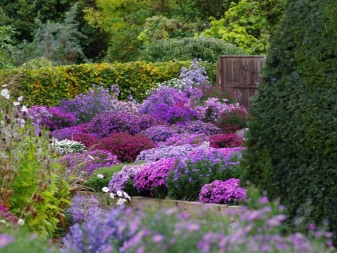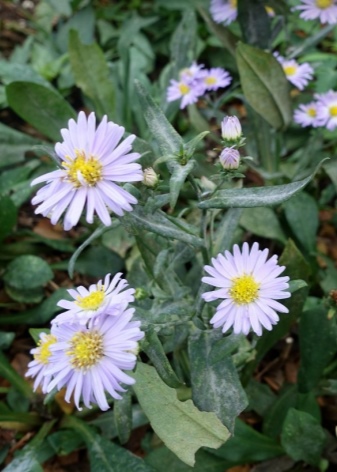Diseases of asters and the fight against them

When deciding which plant to plant on their site, many gardeners make their choice in favor of asters. These beautiful flowers not only decorate the garden, but also do not require complicated maintenance. However, due to the fact that asters are mainly grown from seeds, they are very susceptible to a variety of diseases and pests.

Causes of occurrence
Disease is a common occurrence among asters. Typically, a culture is affected by three types of diseases: viral, bacterial and fungal.
The viral ones are the most dangerous because there is often no cure for them in general.
Such types of ailments are transferred from flower to flower by pests, and they may well fly in from neighboring areas. Another reason for the appearance is contaminated seed. That is, the seeds that the gardener bought are already initially infected with viruses. In addition, there are situations when plants have already died once after a disease, and the land has not been properly cultivated. Then, with a high degree of probability, the virus will attack the culture again.

Bacterial diseases are not so common, but they are also difficult to treat. Bacteria can get into asters in several cases:
- through infected tools;
- in the absence of treatment and disinfection of the plant after pruning, as well as if the branches or stem are damaged.
The most common type of diseases is fungal, and this applies not only to asters, but also to all crops on the site as a whole.

Consider a number of reasons why such diseases appear.
- Failure to comply with the watering regime. Every gardener knows that any plant needs to provide its own watering regime. Astra needs a lot of water, but this does not mean that it needs to be filled. If there is an excess of water, this will be an excellent "starting point" for the development of the fungus.
- High air humidity. The fungus loves moisture and reproduces fastest in rainy summers.
- Too dense planting. When there are too many plants in one area, they begin to "compete" for nutrients in the soil. In addition, certain parts of the culture will not have enough sun, as well as oxygen, since air circulation will be disturbed. In such conditions, the appearance of the fungus is very predictable.


It is worth noting that the above reasons are not always necessarily the cause of the appearance of the fungus.
However, it must be remembered that spores are most successful at attacking weak plants with poor immunity.
If you do not take good care of your pets, do not water properly, do not know what and how to feed, diseases in most cases cannot be avoided.

Overview of diseases
Now that the reasons for the appearance of different types of diseases are clear, it is worthwhile to learn more about the description and symptoms of the most common ailments of asters.
Fusarium
The second name of the disease is fusarium wilting. It is provoked by Fusarium - a special fungus that is located in the ground. If plants are planted on infected soil, the fungus will begin to spread, penetrating the asters through the roots.

The main symptoms are:
- leaves turn yellow, then turn brown, dry up and curl;
- strange brown spots appear on the stems, the stem itself is capable of cracking;
- asters dry on the vine;
- below on the stem you can see pink fluffy growths - these are Fusarium spores.


Blackleg
This is another fungal disease, the development of which is most often noticeable even at the seedling stage. The disease is quite dangerous, young seedlings die from it in just a couple of days.
Signs:
- black areas appear on the stem;
- the base of the plant begins to rot;
- the stalk becomes thin and weak, lies on the ground.


Late blight
A very common disease among horticultural crops. It can easily affect not only asters, but also all nearby plants.
Its symptoms are:
- brown spots appear on the leaves and stem, which look like mold;
- the plant has a strange, cobweb-like bloom.

Powdery mildew
This is one of the diseases that often become a "headache" for the gardener. It occurs in high humidity conditions.
Defined as follows:
- white bloom appears on the asters, which leads to the fact that individual parts of the plant quickly disappear;
- the leaves begin to rapidly turn yellow and wither, they hang lifelessly along the stem;
- flowers are deformed, lose their appearance and color.


Rust
This is an ailment that is also caused by a fungus, and most often this "raider" comes from coniferous crops.
Symptoms:
- at the bottom of the sheet, you can see brown hollow specks - these are pustules, which will soon serve as a place for the accumulation of spores (in the future, the pustule opens on its own, and the spores fall into the ground);
- leaves shriveled, curly, become lethargic and weak, quickly die off.

Brown spot
In another way, this disease is called septoria. Fungal pathogens of the disease love hot and humid weather, in such conditions they rapidly infect asters.
Signs of illness:
- light brown spots begin to form on the foliage, which quickly spread over the entire surface;
- the bush itself takes on an unsightly appearance - it withers, dries, the leaves curl, crumble.

Jaundice
This is one of the viral diseases. Its main carrier is aphids.
Symptoms:
- leaves brighten, then begin to die off;
- the buds turn green, stop growing.

Bacterial spot
The most dangerous disease, the carriers of which calmly winter in the soil and fallen leaves. It begins to spread during the rainy season.
Signs:
- large spots of yellow or light brown hue appear on the leaves;
- then, if you do not take action, the foliage curls and quickly falls off, the bush dies.

Rot
There are several types of rot, but in most cases, the aster is affected by gray. This is a serious bacterial disease that has killed many horticultural crops.
Symptoms:
- the plant turns brown, and absolutely all of its parts;
- rotting of the bush is observed;
- aster is covered with a gray bloom.

Speaking about diseases of culture, one cannot fail to mention that pests often attack it.
Earwig
A nocturnal insect, well recognizable by its long antennae, as well as a pliers-like tail. It devours all parts of the plant, leading to death.

Meadow bug
A tiny, but no less dangerous pest from this, travels through the air. It sucks the juice out of the plant, due to which the flowers and leaves lose their shape, the bush is deformed.

Spider mite
The insect does not disdain anything that is on the site, including asters. It feeds on plant sap, covering them with its thinnest cobweb.


Aphid
A small pest that most often prefers young seedlings. Easily recognizable by slippery and sticky shiny tracks. Over time, it eats up the leaves.

Thrips

Ways to fight
If you see that the plant has withered, it dies in the open field, then you need to urgently look for the cause, otherwise the disease will spread further to neighboring crops. Only a correct understanding of the cause of the disease will make it possible to draw up an effective treatment plan.
Many fungal diseases are treated with good fungicides.

However, each case has its own characteristics.
- Fusarium easier to prevent than to cure. To do this, asters are not planted on the same site all the time; every 4 years you need to alternate with other crops. Before planting, the seeds are soaked in Fundazole, the soil is steamed and lime. For preventive spraying, copper oxychloride is used. If the plant does get sick, the diseased specimens must be destroyed.
- If plants were found infected black leg, they will have to be deleted too. The rest of the seedlings can be treated with potassium permanganate, as well as onion infusion. To prevent the disease from attacking the plants, you need to be careful even at the picking stage. Plant the seedlings in disinfected soil.
- When the appearance late blight it is necessary to cut off the diseased parts with a sharp and sterile pruning shears. The appeared wounds are covered with activated carbon powder. After a couple of hours, both the plants and the soil are treated with fungicides.
- At the initial stage powdery mildew plants are treated with soapy water; onion or tobacco tincture also gives good results. In more advanced cases, the culture will need to be treated with a solution of copper sulfate.
- As soon as it was noticed rust, all diseased parts are cut off immediately. Then it is recommended to treat the plant with powerful fungicides, they also need to be watered the soil. However, the disease can be avoided, for this you simply do not need to plant coniferous crops nearby.
- Concerning septoria, then here the infected parts are also disposed of by pruning. Then, 2 times a month, the plants need to be treated with Bordeaux liquid.
- Prevent the appearance jaundice the fight against the vectors themselves - aphids will help. To get rid of it, you need to brew 800 grams of yarrow in a bucket of water and boil for a couple of hours. Spraying is carried out with the cooled broth. At the same time, the affected specimens are discarded, burning them outside the site.
- Bacterial spot heals well by creating a dry environment. In order for the disease to slow down development, the plant should not be temporarily watered. The soil is disinfected with manganese, and the plants themselves are sprayed with copper sulfate every 3 weeks.



As for pests, at the initial stage, they can be successfully dealt with with soapy water. In addition, some gardeners practice manual collection, but this is relevant only for insects visible to the eye, you cannot collect a tick in this way.
If pests have already flooded the garden, it is recommended to use insecticides, they are different for each type of insect.
For example, "Karbofos" is suitable against ticks, and "Fitoverm" is suitable against thrips.


Prevention measures
Asters that grow in flower beds and garden beds need proper care. Only then will they feel good and will not get sick.

Let's see what needs to be done with this crop to ensure healthy growth and strong immunity.
- Choose the right site before planting. It should be a sunny, not too ventilated place, where there will be no groundwater close to the surface. The soil should be neutral, light, breathable.
- Eliminate feeding with fresh organic matter, this can provoke disease. Only rotted organic dressings are suitable, and even better - mineral and complex ones.
- When planting, keep a distance between the bushes so that the branches do not intertwine. Violation of this rule threatens the rapid spread of the fungus.
- After watering, it is imperative to loosen the ground, because such a simple measure provides excellent oxygen access to the roots, the plants become stronger and stronger. In addition, any weeds you see should be removed immediately.
- If any disease was detected during the season, it is better to plant asters in another place the next year. At the same time, one should not forget about the soil: it is spilled with manganese, and also treated with fungicides. In the fall, all plants are harvested, carefully raking up the fallen leaves.
- Spraying with boric acid solution will be useful and useful for plants.This should be done once a month.



Thus, there are not so many rules that need to be followed in order to protect the aster from diseases. Observing them, you will get beautiful and strong plants that will delight the eye both in the garden and as bouquets.
How to protect asters from disease is described in the video.






































































































The comment was sent successfully.